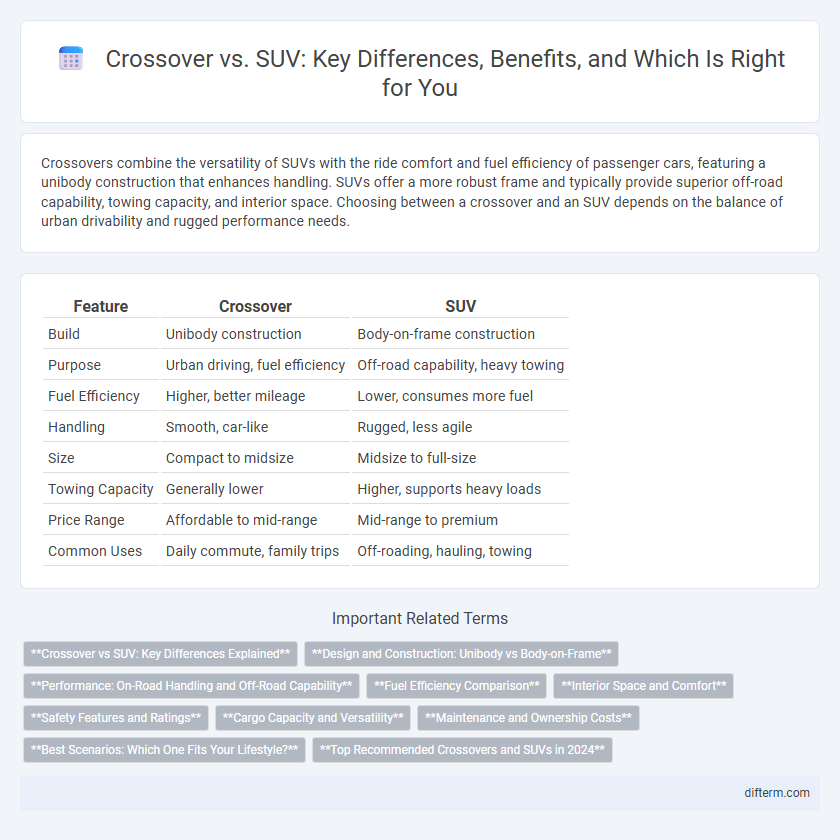Crossovers combine the versatility of SUVs with the ride comfort and fuel efficiency of passenger cars, featuring a unibody construction that enhances handling. SUVs offer a more robust frame and typically provide superior off-road capability, towing capacity, and interior space. Choosing between a crossover and an SUV depends on the balance of urban drivability and rugged performance needs.
Table of Comparison
| Feature | Crossover | SUV |
|---|---|---|
| Build | Unibody construction | Body-on-frame construction |
| Purpose | Urban driving, fuel efficiency | Off-road capability, heavy towing |
| Fuel Efficiency | Higher, better mileage | Lower, consumes more fuel |
| Handling | Smooth, car-like | Rugged, less agile |
| Size | Compact to midsize | Midsize to full-size |
| Towing Capacity | Generally lower | Higher, supports heavy loads |
| Price Range | Affordable to mid-range | Mid-range to premium |
| Common Uses | Daily commute, family trips | Off-roading, hauling, towing |
Crossover vs SUV: Key Differences Explained
Crossovers are built on car platforms, offering better fuel efficiency, nimble handling, and a smoother ride compared to traditional SUVs, which are constructed on truck frames for enhanced towing capacity and off-road durability. SUVs typically feature higher ground clearance and more robust four-wheel-drive systems, making them ideal for rugged terrain and heavy-duty performance. Crossovers prioritize urban and suburban driving comfort, while SUVs excel in versatility and power for both on- and off-road conditions.
Design and Construction: Unibody vs Body-on-Frame
Crossovers feature a unibody design that integrates the body and frame into a single structure, enhancing ride comfort, fuel efficiency, and handling. SUVs commonly use a body-on-frame construction, providing superior durability and off-road capability by mounting the body on a separate, robust frame. This structural difference significantly influences vehicle weight, towing capacity, and overall performance for diverse driving conditions.
Performance: On-Road Handling and Off-Road Capability
Crossover vehicles typically offer superior on-road handling due to their car-based unibody construction, providing better fuel efficiency and smoother rides on paved surfaces. SUVs feature a truck-based body-on-frame design, enhancing off-road capability with higher ground clearance, robust suspension, and four-wheel-drive systems for rugged terrains. Performance differences are crucial for buyers prioritizing either urban agility or off-road durability.
Fuel Efficiency Comparison
Crossovers generally offer better fuel efficiency compared to traditional SUVs due to their lighter weight and car-based unibody construction. Many crossovers achieve average fuel economy ratings between 25 to 30 miles per gallon, whereas larger SUVs often fall in the 15 to 22 miles per gallon range. Advances in hybrid technology are narrowing this gap, but fuel consumption remains a key factor favoring crossovers for urban and long-distance driving.
Interior Space and Comfort
Crossovers generally offer a more car-like ride with spacious interiors designed for passenger comfort, featuring flexible seating arrangements and ample legroom for both front and rear occupants. SUVs, especially larger models, provide more robust interior space with higher headroom and greater cargo capacity, often equipped with premium materials and advanced comfort features suited for long drives and off-road use. The choice between a crossover and an SUV largely depends on the balance between urban comfort and rugged versatility needed by the driver.
Safety Features and Ratings
Crossovers typically offer advanced safety features such as multiple airbags, electronic stability control, and advanced driver-assistance systems (ADAS) designed for urban environments, resulting in high safety ratings from organizations like the IIHS and NHTSA. SUVs often include robust safety technologies such as reinforced frames, adaptive cruise control, collision mitigation braking, and enhanced off-road stability controls, contributing to top-tier crash test scores and comprehensive occupant protection. Both vehicle types prioritize occupant safety but may differ in their approach to handling crash dynamics and driver assistance based on size and intended use.
Cargo Capacity and Versatility
Crossovers typically offer less cargo capacity than traditional SUVs but excel in versatility with fold-flat rear seats and adaptable storage compartments. SUVs provide greater maximum cargo volume, often exceeding 70 cubic feet behind the rear seats, making them ideal for large gear or bulkier items. Both vehicle types cater to active lifestyles, but SUVs maintain a clear advantage in accommodating larger loads and off-road equipment.
Maintenance and Ownership Costs
Crossover vehicles generally incur lower maintenance and ownership costs compared to traditional SUVs due to their car-based platform, which leads to better fuel efficiency and less expensive repairs. SUVs often require more frequent and costly maintenance, including higher expenses for tires, brakes, and suspension components because of their larger size and heavier weight. Insurance premiums for crossovers are typically lower as well, reflecting their reduced risk factors relative to rugged SUVs designed for off-road use.
Best Scenarios: Which One Fits Your Lifestyle?
Crossovers excel in urban commuting and fuel efficiency, making them ideal for small families or individuals navigating city streets with occasional weekend getaways. SUVs offer superior off-road capabilities and towing capacity, perfect for outdoor enthusiasts and those requiring rugged performance in diverse terrains. Selecting between a crossover and SUV depends on lifestyle needs such as cargo space, passenger comfort, and driving conditions.
Top Recommended Crossovers and SUVs in 2024
Top recommended crossovers in 2024 include the Toyota RAV4, Honda CR-V, and Mazda CX-5, known for their fuel efficiency, advanced safety features, and spacious interiors ideal for urban and suburban driving. Leading SUVs like the Ford Bronco, Jeep Grand Cherokee, and Chevrolet Tahoe offer robust off-road capabilities, powerful engine options, and premium technology packages tailored for adventure and family needs. Both segments emphasize cutting-edge connectivity, driver-assist systems, and versatile cargo solutions, catering to diverse automotive preferences and lifestyles.
crossover vs SUV Infographic

 difterm.com
difterm.com